Business Law Report: Analysis of Negligence in a Legal Scenario
VerifiedAdded on 2023/06/08
|8
|2366
|356
Report
AI Summary
This report provides a detailed analysis of a business law case involving negligence. The report examines the key elements of negligence, including duty of care, breach of duty, and causation, referencing relevant legal precedents such as Australian Knitting Mills, Ld. v. Grant, and Donoghue v. Stevenson. The report applies these legal principles to a specific scenario involving a tiger named Benji and his owner, Susan, to determine if a claim of negligence can be established by their neighbors, Cliff and Mary. The analysis covers the establishment of duty of care, breach of duty, and causation, considering vicarious liability and the foreseeability of harm. The report concludes with an assessment of potential damages, considering both property damage and mental injury, and applies relevant case law such as Uren v John Fairfax and Sons Pty Ltd. The report also discusses the concept of remoteness in relation to damages, as per Overseas Tankship (UK) Ltd v Morts Dock & Engineering Co Ltd.
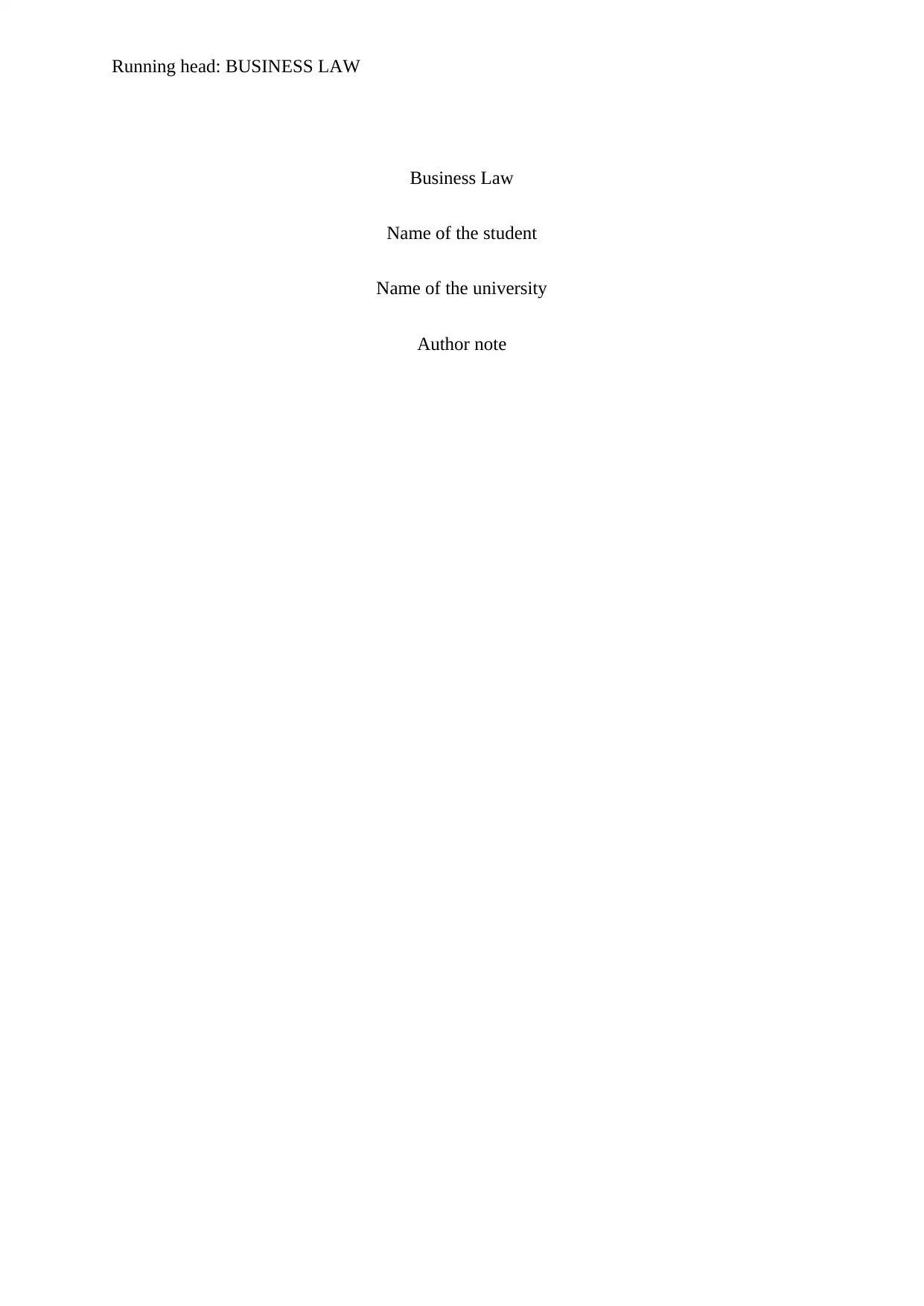
Running head: BUSINESS LAW
Business Law
Name of the student
Name of the university
Author note
Business Law
Name of the student
Name of the university
Author note
Paraphrase This Document
Need a fresh take? Get an instant paraphrase of this document with our AI Paraphraser
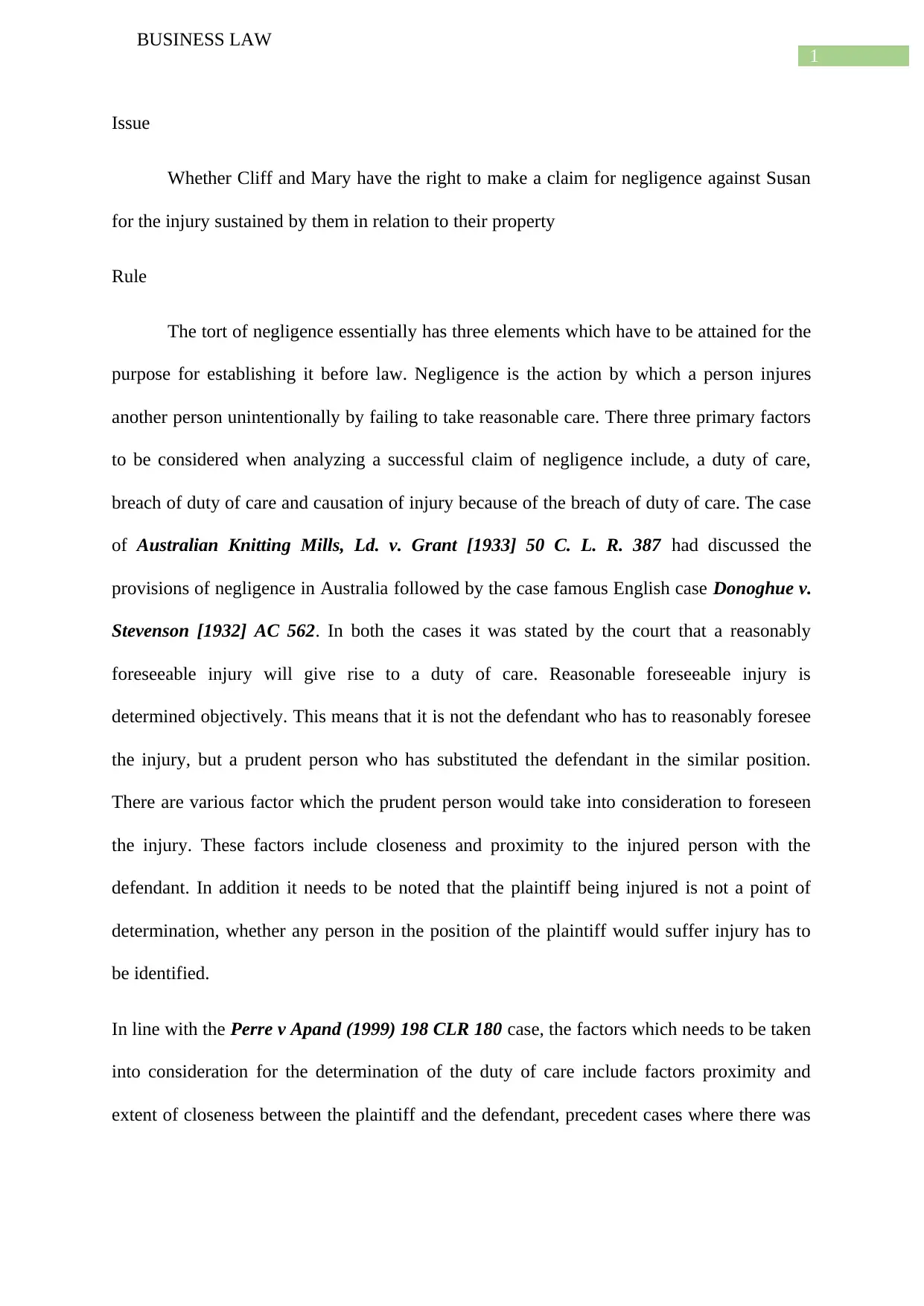
1
BUSINESS LAW
Issue
Whether Cliff and Mary have the right to make a claim for negligence against Susan
for the injury sustained by them in relation to their property
Rule
The tort of negligence essentially has three elements which have to be attained for the
purpose for establishing it before law. Negligence is the action by which a person injures
another person unintentionally by failing to take reasonable care. There three primary factors
to be considered when analyzing a successful claim of negligence include, a duty of care,
breach of duty of care and causation of injury because of the breach of duty of care. The case
of Australian Knitting Mills, Ld. v. Grant [1933] 50 C. L. R. 387 had discussed the
provisions of negligence in Australia followed by the case famous English case Donoghue v.
Stevenson [1932] AC 562. In both the cases it was stated by the court that a reasonably
foreseeable injury will give rise to a duty of care. Reasonable foreseeable injury is
determined objectively. This means that it is not the defendant who has to reasonably foresee
the injury, but a prudent person who has substituted the defendant in the similar position.
There are various factor which the prudent person would take into consideration to foreseen
the injury. These factors include closeness and proximity to the injured person with the
defendant. In addition it needs to be noted that the plaintiff being injured is not a point of
determination, whether any person in the position of the plaintiff would suffer injury has to
be identified.
In line with the Perre v Apand (1999) 198 CLR 180 case, the factors which needs to be taken
into consideration for the determination of the duty of care include factors proximity and
extent of closeness between the plaintiff and the defendant, precedent cases where there was
BUSINESS LAW
Issue
Whether Cliff and Mary have the right to make a claim for negligence against Susan
for the injury sustained by them in relation to their property
Rule
The tort of negligence essentially has three elements which have to be attained for the
purpose for establishing it before law. Negligence is the action by which a person injures
another person unintentionally by failing to take reasonable care. There three primary factors
to be considered when analyzing a successful claim of negligence include, a duty of care,
breach of duty of care and causation of injury because of the breach of duty of care. The case
of Australian Knitting Mills, Ld. v. Grant [1933] 50 C. L. R. 387 had discussed the
provisions of negligence in Australia followed by the case famous English case Donoghue v.
Stevenson [1932] AC 562. In both the cases it was stated by the court that a reasonably
foreseeable injury will give rise to a duty of care. Reasonable foreseeable injury is
determined objectively. This means that it is not the defendant who has to reasonably foresee
the injury, but a prudent person who has substituted the defendant in the similar position.
There are various factor which the prudent person would take into consideration to foreseen
the injury. These factors include closeness and proximity to the injured person with the
defendant. In addition it needs to be noted that the plaintiff being injured is not a point of
determination, whether any person in the position of the plaintiff would suffer injury has to
be identified.
In line with the Perre v Apand (1999) 198 CLR 180 case, the factors which needs to be taken
into consideration for the determination of the duty of care include factors proximity and
extent of closeness between the plaintiff and the defendant, precedent cases where there was
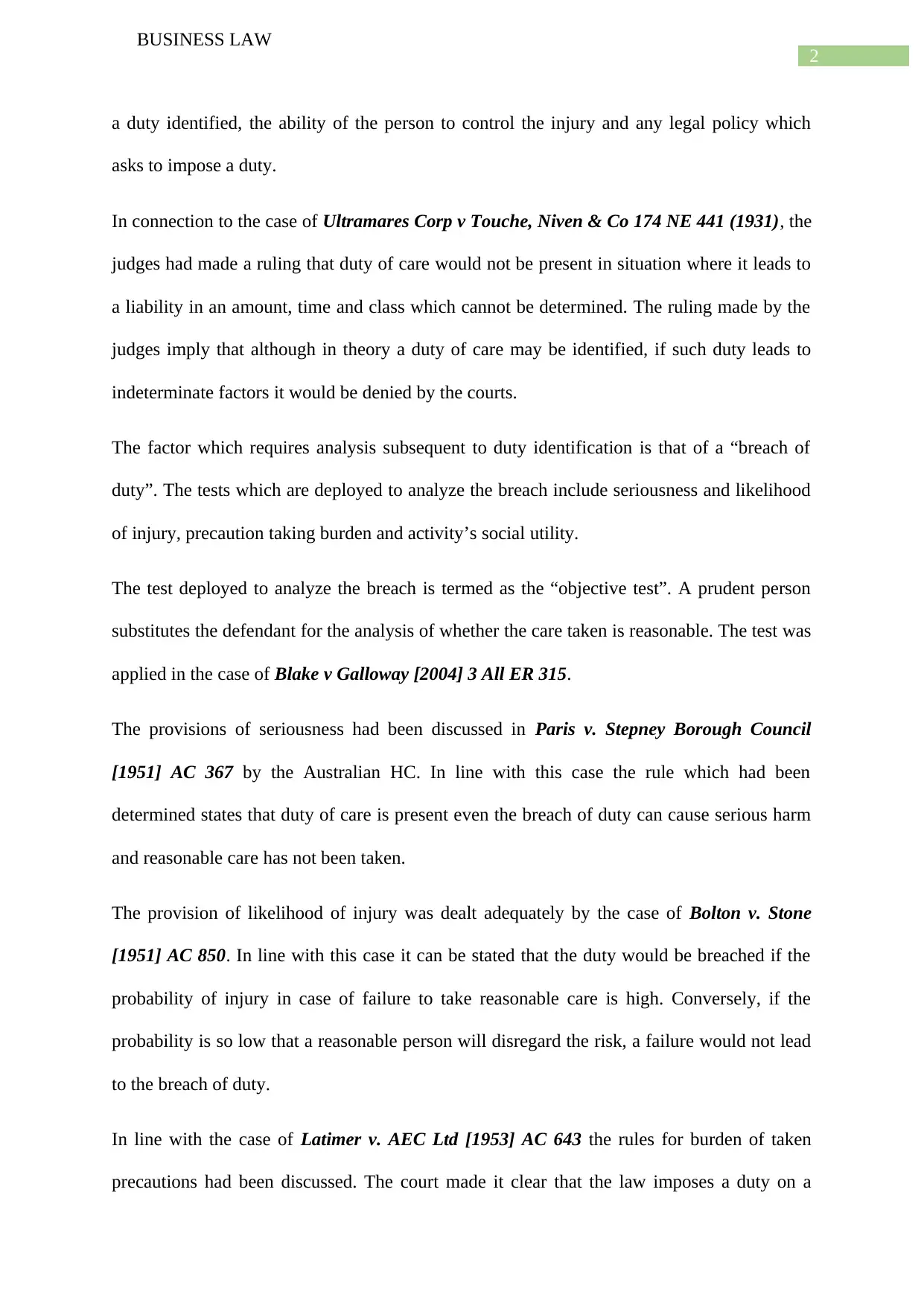
2
BUSINESS LAW
a duty identified, the ability of the person to control the injury and any legal policy which
asks to impose a duty.
In connection to the case of Ultramares Corp v Touche, Niven & Co 174 NE 441 (1931), the
judges had made a ruling that duty of care would not be present in situation where it leads to
a liability in an amount, time and class which cannot be determined. The ruling made by the
judges imply that although in theory a duty of care may be identified, if such duty leads to
indeterminate factors it would be denied by the courts.
The factor which requires analysis subsequent to duty identification is that of a “breach of
duty”. The tests which are deployed to analyze the breach include seriousness and likelihood
of injury, precaution taking burden and activity’s social utility.
The test deployed to analyze the breach is termed as the “objective test”. A prudent person
substitutes the defendant for the analysis of whether the care taken is reasonable. The test was
applied in the case of Blake v Galloway [2004] 3 All ER 315.
The provisions of seriousness had been discussed in Paris v. Stepney Borough Council
[1951] AC 367 by the Australian HC. In line with this case the rule which had been
determined states that duty of care is present even the breach of duty can cause serious harm
and reasonable care has not been taken.
The provision of likelihood of injury was dealt adequately by the case of Bolton v. Stone
[1951] AC 850. In line with this case it can be stated that the duty would be breached if the
probability of injury in case of failure to take reasonable care is high. Conversely, if the
probability is so low that a reasonable person will disregard the risk, a failure would not lead
to the breach of duty.
In line with the case of Latimer v. AEC Ltd [1953] AC 643 the rules for burden of taken
precautions had been discussed. The court made it clear that the law imposes a duty on a
BUSINESS LAW
a duty identified, the ability of the person to control the injury and any legal policy which
asks to impose a duty.
In connection to the case of Ultramares Corp v Touche, Niven & Co 174 NE 441 (1931), the
judges had made a ruling that duty of care would not be present in situation where it leads to
a liability in an amount, time and class which cannot be determined. The ruling made by the
judges imply that although in theory a duty of care may be identified, if such duty leads to
indeterminate factors it would be denied by the courts.
The factor which requires analysis subsequent to duty identification is that of a “breach of
duty”. The tests which are deployed to analyze the breach include seriousness and likelihood
of injury, precaution taking burden and activity’s social utility.
The test deployed to analyze the breach is termed as the “objective test”. A prudent person
substitutes the defendant for the analysis of whether the care taken is reasonable. The test was
applied in the case of Blake v Galloway [2004] 3 All ER 315.
The provisions of seriousness had been discussed in Paris v. Stepney Borough Council
[1951] AC 367 by the Australian HC. In line with this case the rule which had been
determined states that duty of care is present even the breach of duty can cause serious harm
and reasonable care has not been taken.
The provision of likelihood of injury was dealt adequately by the case of Bolton v. Stone
[1951] AC 850. In line with this case it can be stated that the duty would be breached if the
probability of injury in case of failure to take reasonable care is high. Conversely, if the
probability is so low that a reasonable person will disregard the risk, a failure would not lead
to the breach of duty.
In line with the case of Latimer v. AEC Ltd [1953] AC 643 the rules for burden of taken
precautions had been discussed. The court made it clear that the law imposes a duty on a
⊘ This is a preview!⊘
Do you want full access?
Subscribe today to unlock all pages.

Trusted by 1+ million students worldwide
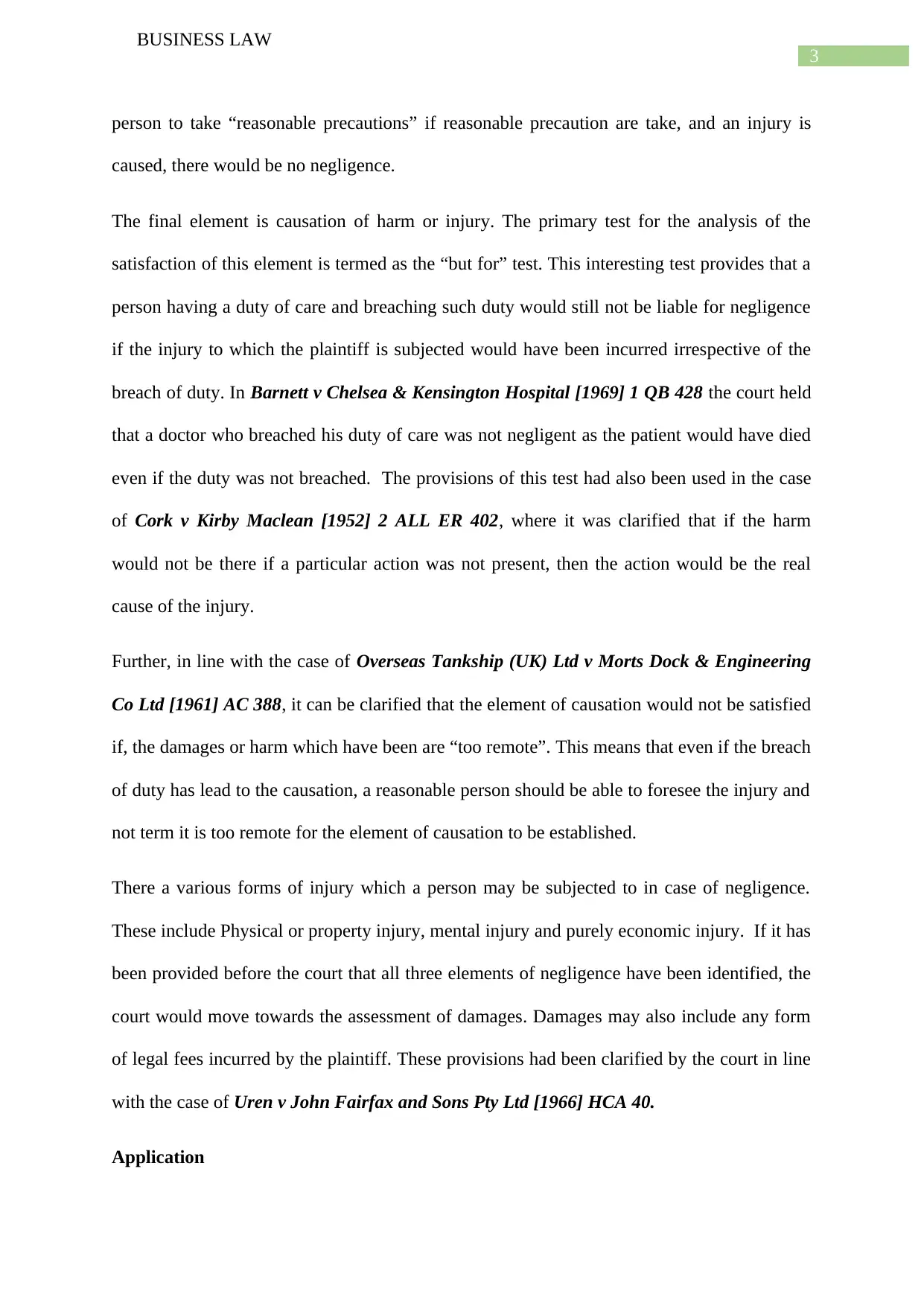
3
BUSINESS LAW
person to take “reasonable precautions” if reasonable precaution are take, and an injury is
caused, there would be no negligence.
The final element is causation of harm or injury. The primary test for the analysis of the
satisfaction of this element is termed as the “but for” test. This interesting test provides that a
person having a duty of care and breaching such duty would still not be liable for negligence
if the injury to which the plaintiff is subjected would have been incurred irrespective of the
breach of duty. In Barnett v Chelsea & Kensington Hospital [1969] 1 QB 428 the court held
that a doctor who breached his duty of care was not negligent as the patient would have died
even if the duty was not breached. The provisions of this test had also been used in the case
of Cork v Kirby Maclean [1952] 2 ALL ER 402, where it was clarified that if the harm
would not be there if a particular action was not present, then the action would be the real
cause of the injury.
Further, in line with the case of Overseas Tankship (UK) Ltd v Morts Dock & Engineering
Co Ltd [1961] AC 388, it can be clarified that the element of causation would not be satisfied
if, the damages or harm which have been are “too remote”. This means that even if the breach
of duty has lead to the causation, a reasonable person should be able to foresee the injury and
not term it is too remote for the element of causation to be established.
There a various forms of injury which a person may be subjected to in case of negligence.
These include Physical or property injury, mental injury and purely economic injury. If it has
been provided before the court that all three elements of negligence have been identified, the
court would move towards the assessment of damages. Damages may also include any form
of legal fees incurred by the plaintiff. These provisions had been clarified by the court in line
with the case of Uren v John Fairfax and Sons Pty Ltd [1966] HCA 40.
Application
BUSINESS LAW
person to take “reasonable precautions” if reasonable precaution are take, and an injury is
caused, there would be no negligence.
The final element is causation of harm or injury. The primary test for the analysis of the
satisfaction of this element is termed as the “but for” test. This interesting test provides that a
person having a duty of care and breaching such duty would still not be liable for negligence
if the injury to which the plaintiff is subjected would have been incurred irrespective of the
breach of duty. In Barnett v Chelsea & Kensington Hospital [1969] 1 QB 428 the court held
that a doctor who breached his duty of care was not negligent as the patient would have died
even if the duty was not breached. The provisions of this test had also been used in the case
of Cork v Kirby Maclean [1952] 2 ALL ER 402, where it was clarified that if the harm
would not be there if a particular action was not present, then the action would be the real
cause of the injury.
Further, in line with the case of Overseas Tankship (UK) Ltd v Morts Dock & Engineering
Co Ltd [1961] AC 388, it can be clarified that the element of causation would not be satisfied
if, the damages or harm which have been are “too remote”. This means that even if the breach
of duty has lead to the causation, a reasonable person should be able to foresee the injury and
not term it is too remote for the element of causation to be established.
There a various forms of injury which a person may be subjected to in case of negligence.
These include Physical or property injury, mental injury and purely economic injury. If it has
been provided before the court that all three elements of negligence have been identified, the
court would move towards the assessment of damages. Damages may also include any form
of legal fees incurred by the plaintiff. These provisions had been clarified by the court in line
with the case of Uren v John Fairfax and Sons Pty Ltd [1966] HCA 40.
Application
Paraphrase This Document
Need a fresh take? Get an instant paraphrase of this document with our AI Paraphraser
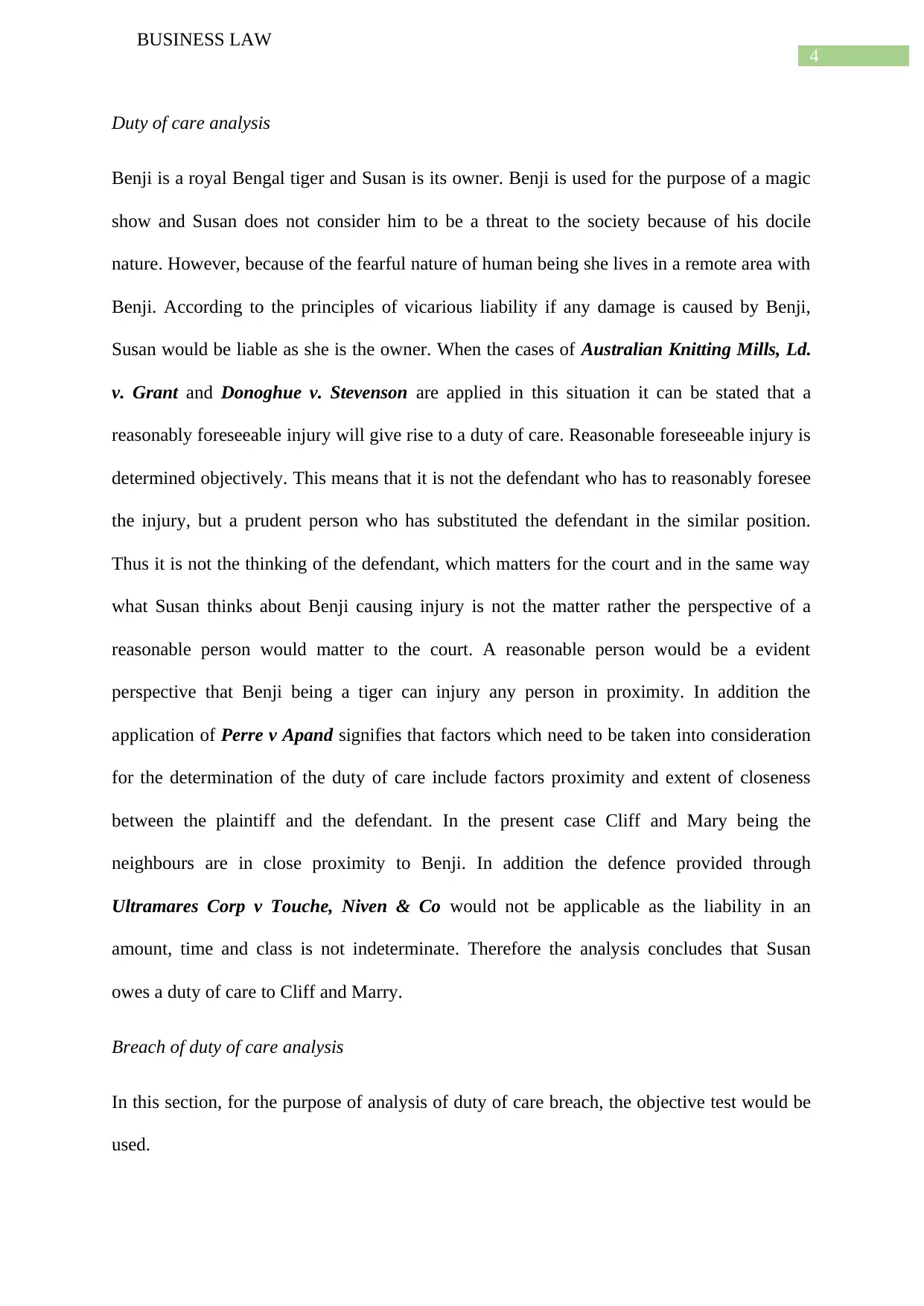
4
BUSINESS LAW
Duty of care analysis
Benji is a royal Bengal tiger and Susan is its owner. Benji is used for the purpose of a magic
show and Susan does not consider him to be a threat to the society because of his docile
nature. However, because of the fearful nature of human being she lives in a remote area with
Benji. According to the principles of vicarious liability if any damage is caused by Benji,
Susan would be liable as she is the owner. When the cases of Australian Knitting Mills, Ld.
v. Grant and Donoghue v. Stevenson are applied in this situation it can be stated that a
reasonably foreseeable injury will give rise to a duty of care. Reasonable foreseeable injury is
determined objectively. This means that it is not the defendant who has to reasonably foresee
the injury, but a prudent person who has substituted the defendant in the similar position.
Thus it is not the thinking of the defendant, which matters for the court and in the same way
what Susan thinks about Benji causing injury is not the matter rather the perspective of a
reasonable person would matter to the court. A reasonable person would be a evident
perspective that Benji being a tiger can injury any person in proximity. In addition the
application of Perre v Apand signifies that factors which need to be taken into consideration
for the determination of the duty of care include factors proximity and extent of closeness
between the plaintiff and the defendant. In the present case Cliff and Mary being the
neighbours are in close proximity to Benji. In addition the defence provided through
Ultramares Corp v Touche, Niven & Co would not be applicable as the liability in an
amount, time and class is not indeterminate. Therefore the analysis concludes that Susan
owes a duty of care to Cliff and Marry.
Breach of duty of care analysis
In this section, for the purpose of analysis of duty of care breach, the objective test would be
used.
BUSINESS LAW
Duty of care analysis
Benji is a royal Bengal tiger and Susan is its owner. Benji is used for the purpose of a magic
show and Susan does not consider him to be a threat to the society because of his docile
nature. However, because of the fearful nature of human being she lives in a remote area with
Benji. According to the principles of vicarious liability if any damage is caused by Benji,
Susan would be liable as she is the owner. When the cases of Australian Knitting Mills, Ld.
v. Grant and Donoghue v. Stevenson are applied in this situation it can be stated that a
reasonably foreseeable injury will give rise to a duty of care. Reasonable foreseeable injury is
determined objectively. This means that it is not the defendant who has to reasonably foresee
the injury, but a prudent person who has substituted the defendant in the similar position.
Thus it is not the thinking of the defendant, which matters for the court and in the same way
what Susan thinks about Benji causing injury is not the matter rather the perspective of a
reasonable person would matter to the court. A reasonable person would be a evident
perspective that Benji being a tiger can injury any person in proximity. In addition the
application of Perre v Apand signifies that factors which need to be taken into consideration
for the determination of the duty of care include factors proximity and extent of closeness
between the plaintiff and the defendant. In the present case Cliff and Mary being the
neighbours are in close proximity to Benji. In addition the defence provided through
Ultramares Corp v Touche, Niven & Co would not be applicable as the liability in an
amount, time and class is not indeterminate. Therefore the analysis concludes that Susan
owes a duty of care to Cliff and Marry.
Breach of duty of care analysis
In this section, for the purpose of analysis of duty of care breach, the objective test would be
used.
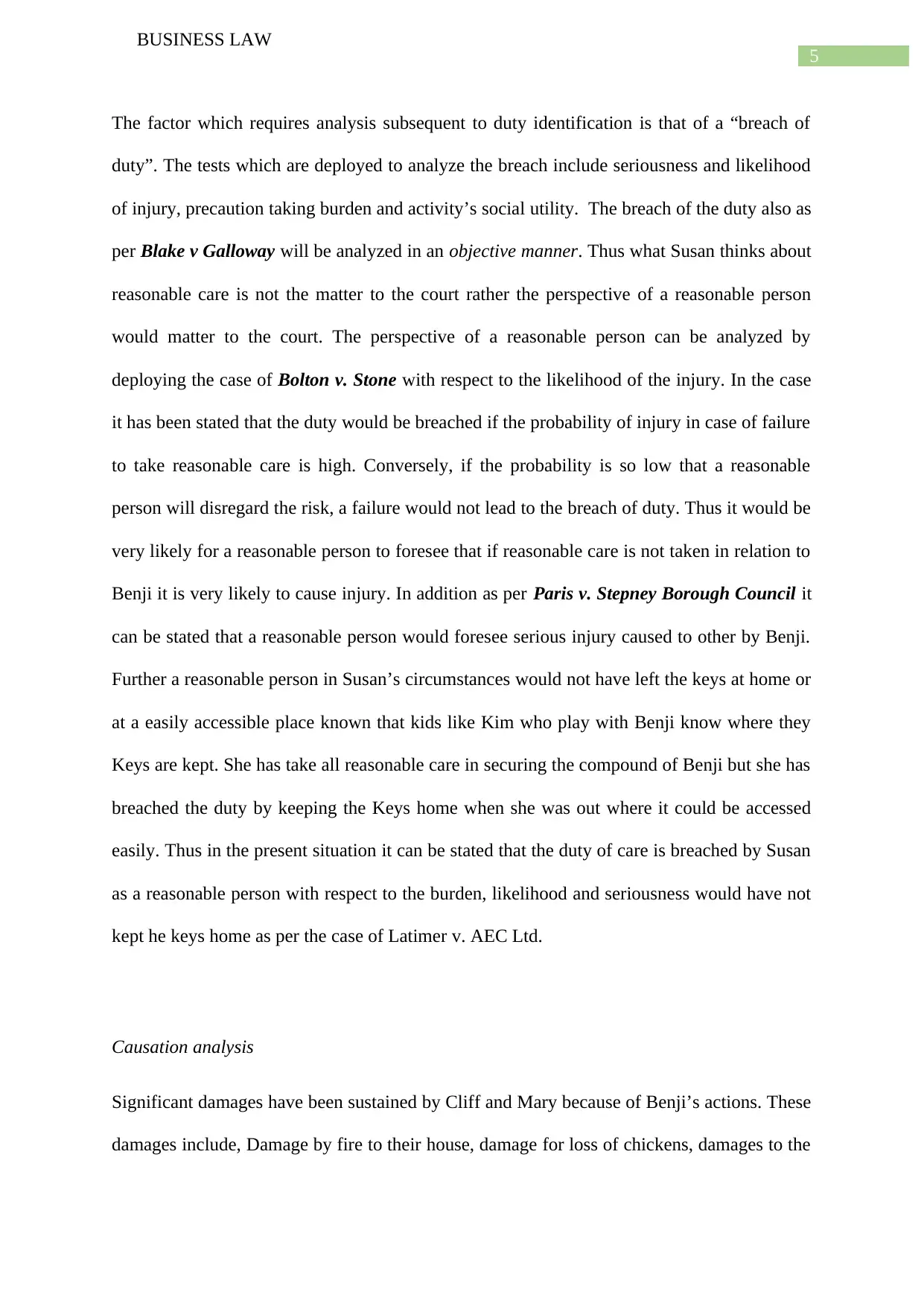
5
BUSINESS LAW
The factor which requires analysis subsequent to duty identification is that of a “breach of
duty”. The tests which are deployed to analyze the breach include seriousness and likelihood
of injury, precaution taking burden and activity’s social utility. The breach of the duty also as
per Blake v Galloway will be analyzed in an objective manner. Thus what Susan thinks about
reasonable care is not the matter to the court rather the perspective of a reasonable person
would matter to the court. The perspective of a reasonable person can be analyzed by
deploying the case of Bolton v. Stone with respect to the likelihood of the injury. In the case
it has been stated that the duty would be breached if the probability of injury in case of failure
to take reasonable care is high. Conversely, if the probability is so low that a reasonable
person will disregard the risk, a failure would not lead to the breach of duty. Thus it would be
very likely for a reasonable person to foresee that if reasonable care is not taken in relation to
Benji it is very likely to cause injury. In addition as per Paris v. Stepney Borough Council it
can be stated that a reasonable person would foresee serious injury caused to other by Benji.
Further a reasonable person in Susan’s circumstances would not have left the keys at home or
at a easily accessible place known that kids like Kim who play with Benji know where they
Keys are kept. She has take all reasonable care in securing the compound of Benji but she has
breached the duty by keeping the Keys home when she was out where it could be accessed
easily. Thus in the present situation it can be stated that the duty of care is breached by Susan
as a reasonable person with respect to the burden, likelihood and seriousness would have not
kept he keys home as per the case of Latimer v. AEC Ltd.
Causation analysis
Significant damages have been sustained by Cliff and Mary because of Benji’s actions. These
damages include, Damage by fire to their house, damage for loss of chickens, damages to the
BUSINESS LAW
The factor which requires analysis subsequent to duty identification is that of a “breach of
duty”. The tests which are deployed to analyze the breach include seriousness and likelihood
of injury, precaution taking burden and activity’s social utility. The breach of the duty also as
per Blake v Galloway will be analyzed in an objective manner. Thus what Susan thinks about
reasonable care is not the matter to the court rather the perspective of a reasonable person
would matter to the court. The perspective of a reasonable person can be analyzed by
deploying the case of Bolton v. Stone with respect to the likelihood of the injury. In the case
it has been stated that the duty would be breached if the probability of injury in case of failure
to take reasonable care is high. Conversely, if the probability is so low that a reasonable
person will disregard the risk, a failure would not lead to the breach of duty. Thus it would be
very likely for a reasonable person to foresee that if reasonable care is not taken in relation to
Benji it is very likely to cause injury. In addition as per Paris v. Stepney Borough Council it
can be stated that a reasonable person would foresee serious injury caused to other by Benji.
Further a reasonable person in Susan’s circumstances would not have left the keys at home or
at a easily accessible place known that kids like Kim who play with Benji know where they
Keys are kept. She has take all reasonable care in securing the compound of Benji but she has
breached the duty by keeping the Keys home when she was out where it could be accessed
easily. Thus in the present situation it can be stated that the duty of care is breached by Susan
as a reasonable person with respect to the burden, likelihood and seriousness would have not
kept he keys home as per the case of Latimer v. AEC Ltd.
Causation analysis
Significant damages have been sustained by Cliff and Mary because of Benji’s actions. These
damages include, Damage by fire to their house, damage for loss of chickens, damages to the
⊘ This is a preview!⊘
Do you want full access?
Subscribe today to unlock all pages.

Trusted by 1+ million students worldwide
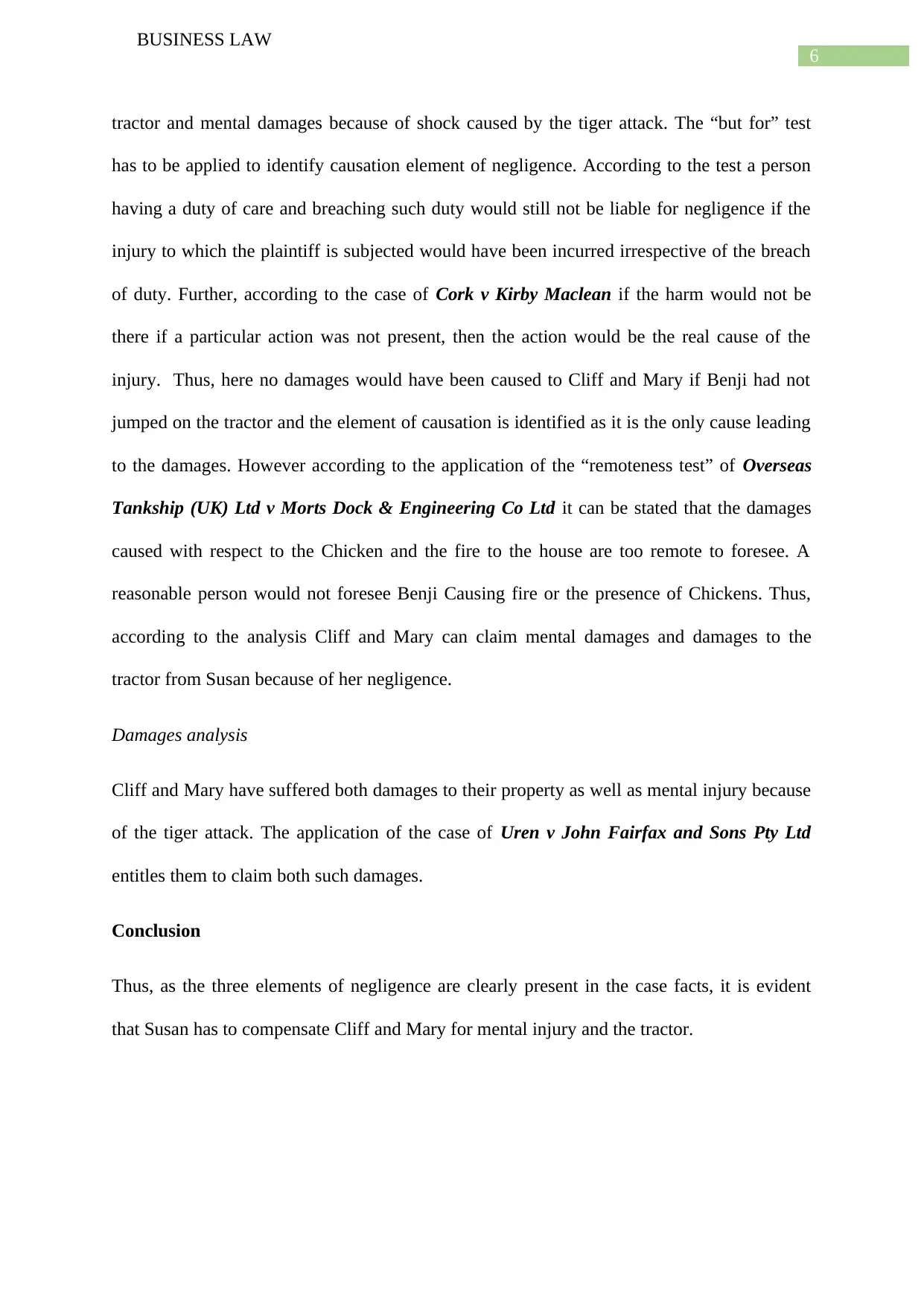
6
BUSINESS LAW
tractor and mental damages because of shock caused by the tiger attack. The “but for” test
has to be applied to identify causation element of negligence. According to the test a person
having a duty of care and breaching such duty would still not be liable for negligence if the
injury to which the plaintiff is subjected would have been incurred irrespective of the breach
of duty. Further, according to the case of Cork v Kirby Maclean if the harm would not be
there if a particular action was not present, then the action would be the real cause of the
injury. Thus, here no damages would have been caused to Cliff and Mary if Benji had not
jumped on the tractor and the element of causation is identified as it is the only cause leading
to the damages. However according to the application of the “remoteness test” of Overseas
Tankship (UK) Ltd v Morts Dock & Engineering Co Ltd it can be stated that the damages
caused with respect to the Chicken and the fire to the house are too remote to foresee. A
reasonable person would not foresee Benji Causing fire or the presence of Chickens. Thus,
according to the analysis Cliff and Mary can claim mental damages and damages to the
tractor from Susan because of her negligence.
Damages analysis
Cliff and Mary have suffered both damages to their property as well as mental injury because
of the tiger attack. The application of the case of Uren v John Fairfax and Sons Pty Ltd
entitles them to claim both such damages.
Conclusion
Thus, as the three elements of negligence are clearly present in the case facts, it is evident
that Susan has to compensate Cliff and Mary for mental injury and the tractor.
BUSINESS LAW
tractor and mental damages because of shock caused by the tiger attack. The “but for” test
has to be applied to identify causation element of negligence. According to the test a person
having a duty of care and breaching such duty would still not be liable for negligence if the
injury to which the plaintiff is subjected would have been incurred irrespective of the breach
of duty. Further, according to the case of Cork v Kirby Maclean if the harm would not be
there if a particular action was not present, then the action would be the real cause of the
injury. Thus, here no damages would have been caused to Cliff and Mary if Benji had not
jumped on the tractor and the element of causation is identified as it is the only cause leading
to the damages. However according to the application of the “remoteness test” of Overseas
Tankship (UK) Ltd v Morts Dock & Engineering Co Ltd it can be stated that the damages
caused with respect to the Chicken and the fire to the house are too remote to foresee. A
reasonable person would not foresee Benji Causing fire or the presence of Chickens. Thus,
according to the analysis Cliff and Mary can claim mental damages and damages to the
tractor from Susan because of her negligence.
Damages analysis
Cliff and Mary have suffered both damages to their property as well as mental injury because
of the tiger attack. The application of the case of Uren v John Fairfax and Sons Pty Ltd
entitles them to claim both such damages.
Conclusion
Thus, as the three elements of negligence are clearly present in the case facts, it is evident
that Susan has to compensate Cliff and Mary for mental injury and the tractor.
Paraphrase This Document
Need a fresh take? Get an instant paraphrase of this document with our AI Paraphraser
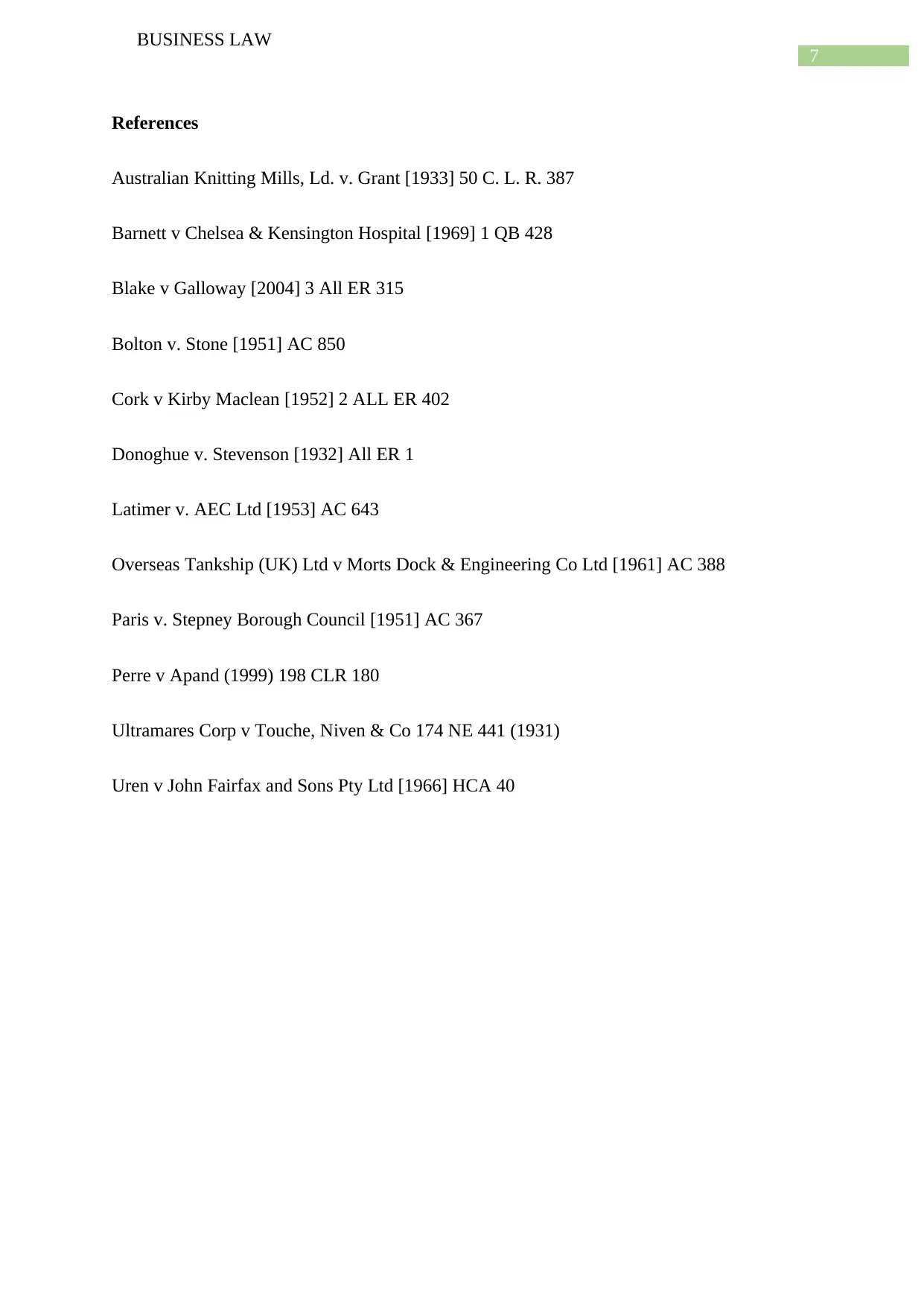
7
BUSINESS LAW
References
Australian Knitting Mills, Ld. v. Grant [1933] 50 C. L. R. 387
Barnett v Chelsea & Kensington Hospital [1969] 1 QB 428
Blake v Galloway [2004] 3 All ER 315
Bolton v. Stone [1951] AC 850
Cork v Kirby Maclean [1952] 2 ALL ER 402
Donoghue v. Stevenson [1932] All ER 1
Latimer v. AEC Ltd [1953] AC 643
Overseas Tankship (UK) Ltd v Morts Dock & Engineering Co Ltd [1961] AC 388
Paris v. Stepney Borough Council [1951] AC 367
Perre v Apand (1999) 198 CLR 180
Ultramares Corp v Touche, Niven & Co 174 NE 441 (1931)
Uren v John Fairfax and Sons Pty Ltd [1966] HCA 40
BUSINESS LAW
References
Australian Knitting Mills, Ld. v. Grant [1933] 50 C. L. R. 387
Barnett v Chelsea & Kensington Hospital [1969] 1 QB 428
Blake v Galloway [2004] 3 All ER 315
Bolton v. Stone [1951] AC 850
Cork v Kirby Maclean [1952] 2 ALL ER 402
Donoghue v. Stevenson [1932] All ER 1
Latimer v. AEC Ltd [1953] AC 643
Overseas Tankship (UK) Ltd v Morts Dock & Engineering Co Ltd [1961] AC 388
Paris v. Stepney Borough Council [1951] AC 367
Perre v Apand (1999) 198 CLR 180
Ultramares Corp v Touche, Niven & Co 174 NE 441 (1931)
Uren v John Fairfax and Sons Pty Ltd [1966] HCA 40
1 out of 8
Related Documents
Your All-in-One AI-Powered Toolkit for Academic Success.
+13062052269
info@desklib.com
Available 24*7 on WhatsApp / Email
![[object Object]](/_next/static/media/star-bottom.7253800d.svg)
Unlock your academic potential
Copyright © 2020–2025 A2Z Services. All Rights Reserved. Developed and managed by ZUCOL.





